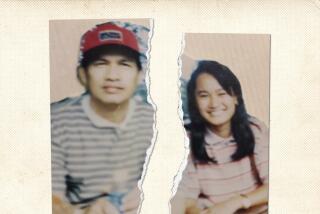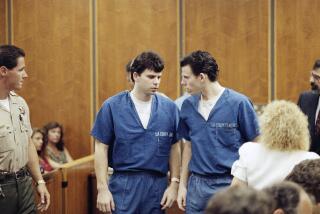Celebrity status a key issue for jurors
Is pop music pioneer Phil Spector a murderer trying to use his wealth to buy an acquittal? Or did prosecutors, eager to put a celebrity behind bars, ignore proof that a troubled Hollywood hanger-on took her own life in Spector’s Alhambra mansion?
As a Los Angeles jury begins deliberating Spector’s fate, it will face these questions that evoke both film noir motifs and the recent history of celebrity justice in Los Angeles. The eccentric 67-year-old producer, once known as a boy genius who created early rock’s “Wall of Sound,” is charged with second-degree murder in the shooting death of Lana Clarkson on Feb. 3, 2003.
The case is slated to go to the jury today after more than four months of testimony and more than four years after Clarkson, 40, an actress who appeared in the Roger Corman cult film “Barbarian Queen,” was found slumped in a chair in the foyer of Spector’s faux castle, shot through the mouth.
Prosecutors say Spector had a long history of gun threats against women and put a loaded snub-nosed revolver in Clarkson’s face when she tried to leave. Whether he meant to kill her is irrelevant, they argue; his knowing disregard for life would constitute murder under California law.
The defense, backed by celebrity forensic experts, argues that Clarkson, facing fading acting prospects and mounting financial problems, shot herself. She was working a $9-an-hour job as hostess at the House of Blues when she met Spector and agreed to accompany him home the night she died.
Before the Spector case, which has been carried on television and the Internet, O.J. Simpson’s was the last televised murder trial of a celebrity. Simpson’s acquittal was followed by that of actor Robert Blake, who had been accused of killing his wife. Commentators said Los Angeles prosecutors weren’t able, or star-struck Los Angeles juries weren’t willing, to put wealthy celebrities in prison.
The diminutive Spector, who produced music for John Lennon, Ike and Tina Turner and the Ramones, is better known to music makers than to music fans. But for Los Angeles County Dist. Atty. Steve Cooley, a win in the televised trial would dispel perceptions that famous defendants here can beat the system. The Spector trial judge, Larry Paul Fidler, said one reason he decided to allow cameras in his courtroom was to show the public that justice in Los Angeles is dispensed fairly.
From the beginning, prosecutors laid out a case based on character and motives. Deputy Dist. Atty. Alan Jackson called Spector a “sinister and deadly” drunk with a “very rich history of violence.”
After shooting Clarkson, Jackson said, Spector tried to clean up the scene, wiping her with a cloth diaper, and spreading her blood around the house -- it was found on a banister and a doorknob. He described Spector’s statement to his driver as a confession.
Spector launched his case with a fearsome -- and large -- defense team.
After falling out with two high-profile Los Angeles attorneys, Robert Shapiro and Leslie Abramson, Spector hired Bruce Cutler, a New Yorker and a bit of celebrity himself for his representation of mob boss John Gotti. Cutler led off the defense by saying his client had been set up by police with “murder on their minds” and railroaded by spiteful women and a disgruntled employee, driver Adriano DeSouza.
Cutler, however, was soon sidelined by other lawyers, and as testimony concluded, he stepped down from the defense, saying his strategy and that of Spector and the rest of the team had diverged.
Into the breach stepped Linda Kenney Baden, one of Spector’s three lawyers specializing in scientific evidence. Kenney Baden, in her opening statement, said science would refute the prosecution’s emotionally charged tale of a mad, murderous Spector.
The defense, she said, would call eminent forensic scientists, including famous Connecticut criminalist Henry C. Lee, to prove with physical evidence what the prosecution could only allege through testimony from mistaken or biased people.
Prosecution testimony began in late April with the chilling accounts of four women who said they had faced a gun-wielding Spector. They each described incidents in the 1980s and ‘90s in which a drunk Spector pulled guns on them when they tried to leave his home or refused to join him in his hotel room. One said she was pistol-whipped.
Dorothy Melvin, a former manager for comedian Joan Rivers, said the normally charming Spector, when drunk, “turns on a dime and becomes a lunatic.” The other women told similar stories.
Last month, prosecutors called a fifth woman, former Spector assistant Devra Robitaille, who also said Spector had pointed a gun at her when she rejected his advances.
In May, DeSouza, who prosecutors described as a direct witness to the shooting, took the stand. Cutler had dismissed the driver as “an illegal immigrant” who had been sleeping in Spector’s car “full of snacks, cookies and water.” DeSouza could have misheard Spector, Cutler had said, because of the noise of a nearby fountain and his poor command of English.
But DeSouza stood up to three days of cross-examination by Spector attorney Bradley Brunon. Communicating clearly in English, he testified he had earned a college degree in Brazil, where he had also been an Army officer. When asked to describe Spector’s speech, DeSouza did a spontaneous impression of his boss, capturing dead-on Spector’s nasal inflections and sending the courtroom into riotous laughter.
While DeSouza’s coolness under fire was a boost to the prosecution, the defense suffered a remarkable setback. Fidler ruled that star witness Lee had removed a piece of evidence from Spector’s house and failed to turned it over to prosecutors as required by law.
Prosecutors said it was a piece of Clarkson’s acrylic fingernail blown off by the gun blast, which could show she didn’t pull the trigger on the murder weapon.
Lee vehemently denied finding such an item, but Fidler imposed a measured penalty: Prosecutors could tell jurors about the missing item and let them judge for themselves whether Lee broke evidence rules.
Lee never testified.
Instead, the defense, starting in late June, brought forth three famous forensic pathologists, beginning with former Bexar County, Texas, medical examiner Vincent DiMaio.
DiMaio introduced the basic defense argument: Clarkson was shot in the mouth, a cause of death that in nearly all cases indicates suicide. She was depressed over her faltering career, finances and love life. Alcohol and Vicodin impaired her judgment. The large amount of blood and tissue on her body, contrasted with the relatively small amount on Spector, showed she must have fired the gun as he looked on at a distance.
Former Wayne County, Mich., medical examiner Werner Spitz and forensic pathologist Michael Baden, the husband of Spector’s lawyer, also testified. Their conclusions matched DiMaio’s.
Baden later became the subject of a second defense misconduct ruling. Late in the case, he electrified the courtroom with a surprise theory of Clarkson’s death: The 40-year-old actress did not die instantly, but lived for a few minutes after she was shot, during which time she could have coughed up blood onto Spector’s jacket.
The prosecution exploded in protest over the late disclosure of what Baden referred to as his “aha moment.” Fidler ruled the jury also would be told about this defense breach.
Along with science, the defense brought forth witnesses to testify that Clarkson, who had suffered a serious accident that stalled her career, was so despondent she could have killed herself.
The witnesses described her as distraught over being relegated to serving former acting rivals at the House of Blues. Nightclub promoter Punkin Laughlin, who described herself as Clarkson’s close friend, testified that days before her death, Clarkson was extremely upset over a snub from “Transformers” director Michael Bay.
The accusation drew to the courtroom Bay himself, who told jurors he had worked with Clarkson, was fond of her and would never have snubbed her. Prosecutors dismissed Laughlin, who calls herself “Punkin Pie,” as an attention seeker who “named herself for a Thanksgiving dessert.”
As final arguments rolled out last week, prosecutors contended they had revealed the “real Phil Spector: a murderer” who “thinks if he throws enough money at a problem, he can solve the problem.”
The defense team, in turn, invoked Spector’s fame, accusing prosecutors of trying to make the music producer “the first celebrity notch in the government’s gun belt.”
But prosecutors said the defense experts were hired guns parroting a script: “Pay to say,” Jackson called it, and a “checkbook defense.”
Now, it is up to the twelve people, who have spent the last four months in the center of a clash between the state and a famous and wealthy defendant, to settle the score.
--
More to Read
Sign up for Essential California
The most important California stories and recommendations in your inbox every morning.
You may occasionally receive promotional content from the Los Angeles Times.










